weight BMW 3 SERIES 2011 Owners Manual
[x] Cancel search | Manufacturer: BMW, Model Year: 2011, Model line: 3 SERIES, Model: BMW 3 SERIES 2011Pages: 325, PDF Size: 12.94 MB
Page 46 of 325
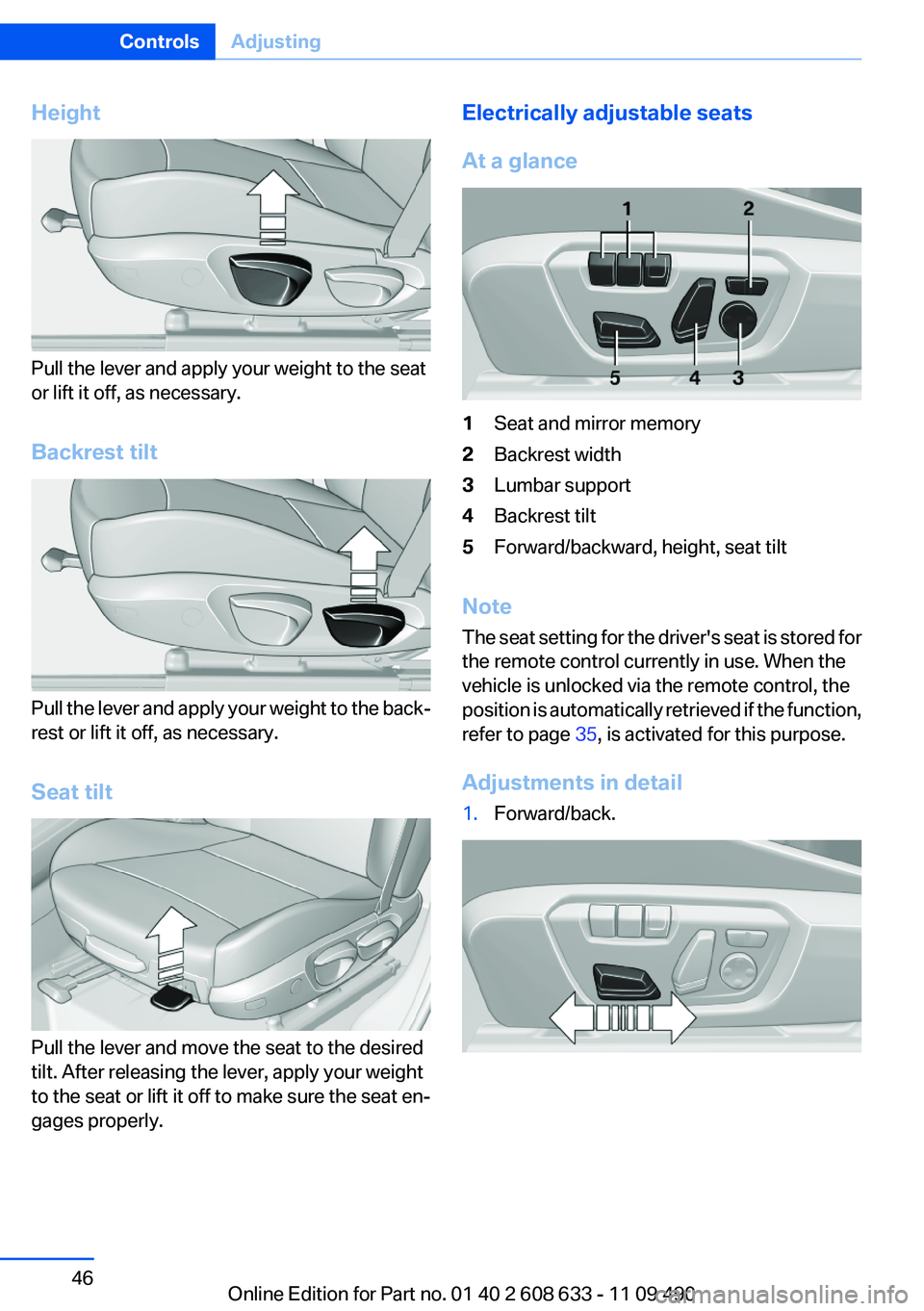
Height
Pull the lever and apply your weight to the seat
or lift it off, as necessary.
Backrest tilt
Pull the lever and apply your weight to the back‐
rest or lift it off, as necessary.
Seat tilt
Pull the lever and move the seat to the desired
tilt. After releasing the lever, apply your weight
to the seat or lift it off to make sure the seat en‐
gages properly.
Electrically adjustable seats
At a glance
1Seat and mirror memory
2Backrest width
3Lumbar support
4Backrest tilt
5Forward/backward, height, seat tilt
Note
The seat setting for the driver's seat is stored for
the remote control currently in use. When the
vehicle is unlocked via the remote control, the
position is automatically retrieved if the function,
refer to page 35, is activated for this purpose.
Adjustments in detail
1.Forward/back.
Seite 46
ControlsAdjusting
46Online Edition for Part no. 01 40 2 608 633 - 11 09 490
Page 55 of 325
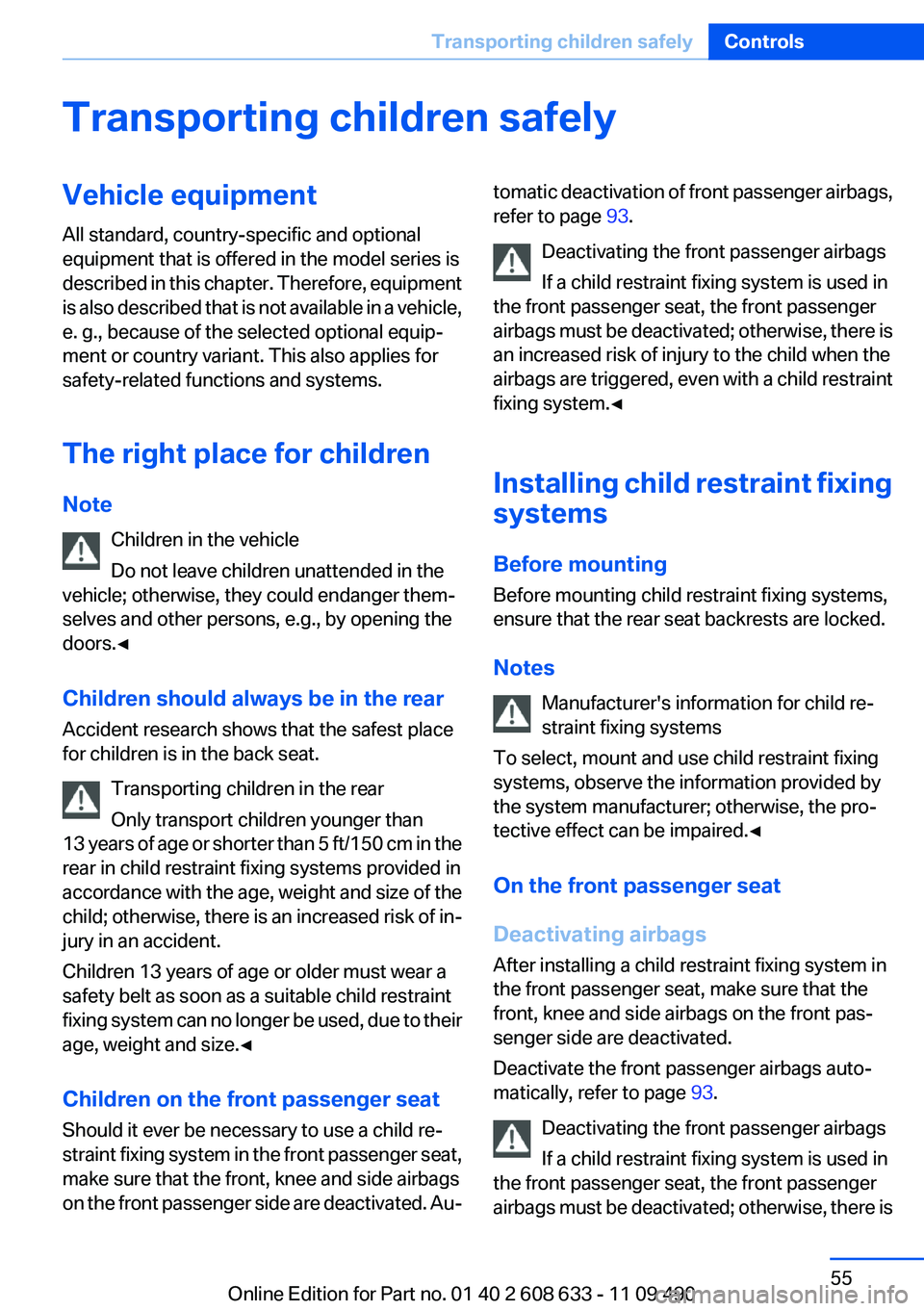
Transporting children safely
Vehicle equipment
All standard, country-specific and optional
equipment that is offered in the model series is
described in this chapter. Therefore, equipment
is also described that is not available in a vehicle,
e. g., because of the selected optional equip‐
ment or country variant. This also applies for
safety-related functions and systems.
The right place for children
Note
Children in the vehicle
Do not leave children unattended in the
vehicle; otherwise, they could endanger them‐
selves and other persons, e.g., by opening the
doors.◀
Children should always be in the rear
Accident research shows that the safest place
for children is in the back seat.
Transporting children in the rear
Only transport children younger than
13 years of age or shorter than 5 ft/150 cm in the
rear in child restraint fixing systems provided in
accordance with the age, weight and size of the
child; otherwise, there is an increased risk of in‐
jury in an accident.
Children 13 years of age or older must wear a
safety belt as soon as a suitable child restraint
fixing system can no longer be used, due to their
age, weight and size.◀
Children on the front passenger seat
Should it ever be necessary to use a child re‐
straint fixing system in the front passenger seat,
make sure that the front, knee and side airbags
on the front passenger side are deactivated. Au‐
tomatic deactivation of front passenger airbags,
refer to page 93.
Deactivating the front passenger airbags
If a child restraint fixing system is used in
the front passenger seat, the front passenger
airbags must be deactivated; otherwise, there is
an increased risk of injury to the child when the
airbags are triggered, even with a child restraint
fixing system.◀
Installing child restraint fixing
systems
Before mounting
Before mounting child restraint fixing systems,
ensure that the rear seat backrests are locked.
Notes
Manufacturer's information for child re‐
straint fixing systems
To select, mount and use child restraint fixing
systems, observe the information provided by
the system manufacturer; otherwise, the pro‐
tective effect can be impaired.◀
On the front passenger seat
Deactivating airbags
After installing a child restraint fixing system in
the front passenger seat, make sure that the
front, knee and side airbags on the front pas‐
senger side are deactivated.
Deactivate the front passenger airbags auto‐
matically, refer to page 93.
Deactivating the front passenger airbags
If a child restraint fixing system is used in
the front passenger seat, the front passenger
airbags must be deactivated; otherwise, there is
Seite 55
Transporting children safelyControls
55Online Edition for Part no. 01 40 2 608 633 - 11 09 490
Page 159 of 325
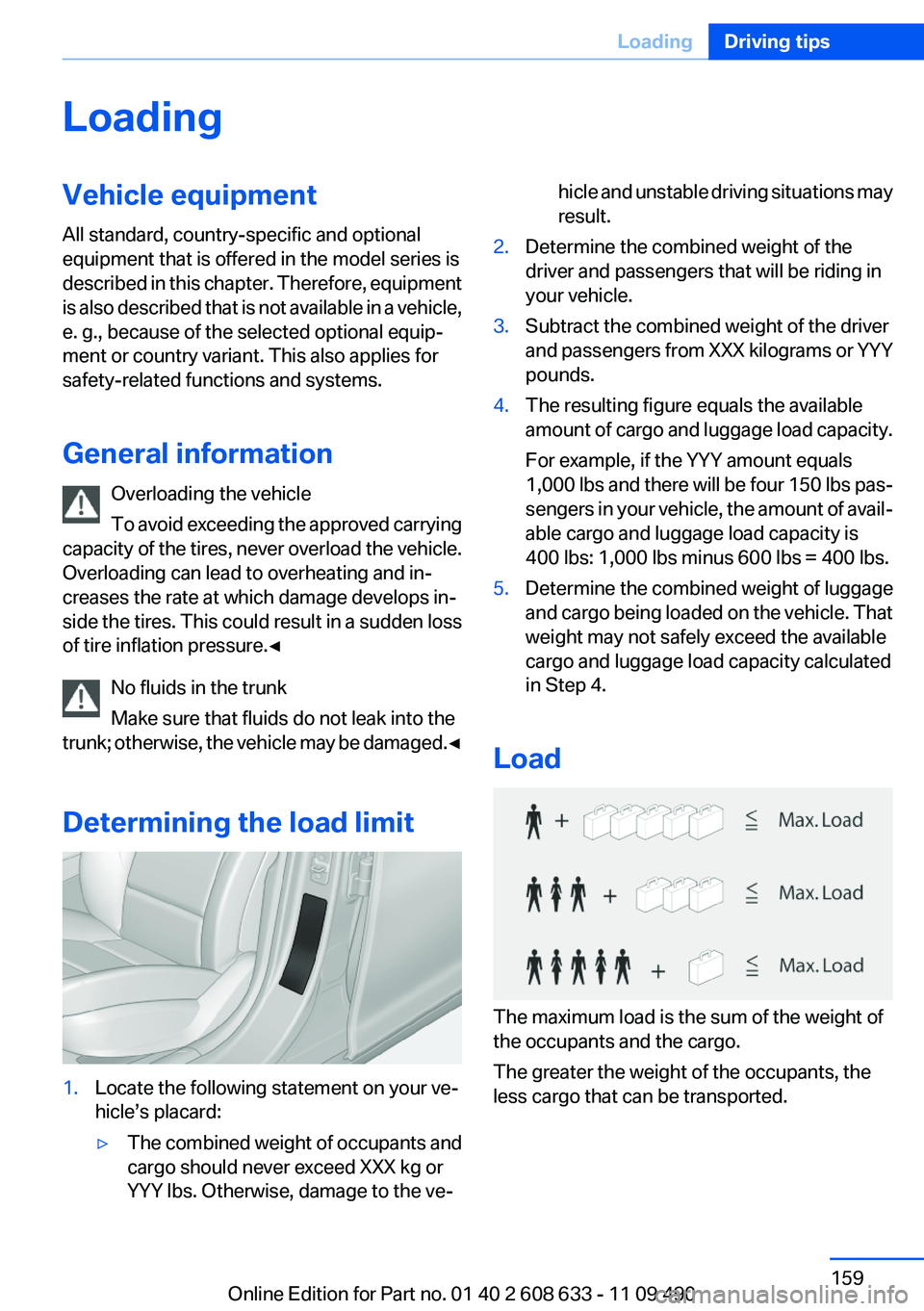
Loading
Vehicle equipment
All standard, country-specific and optional
equipment that is offered in the model series is
described in this chapter. Therefore, equipment
is also described that is not available in a vehicle,
e. g., because of the selected optional equip‐
ment or country variant. This also applies for
safety-related functions and systems.
General information
Overloading the vehicle
To avoid exceeding the approved carrying
capacity of the tires, never overload the vehicle.
Overloading can lead to overheating and in‐
creases the rate at which damage develops in‐
side the tires. This could result in a sudden loss
of tire inflation pressure.◀
No fluids in the trunk
Make sure that fluids do not leak into the
trunk; otherwise, the vehicle may be damaged.◀
Determining the load limit
1.Locate the following statement on your ve‐
hicle’s placard:
▷The combined weight of occupants and
cargo should never exceed XXX kg or
YYY lbs. Otherwise, damage to the ve‐
hicle and unstable driving situations may
result.
2.Determine the combined weight of the
driver and passengers that will be riding in
your vehicle.
3.Subtract the combined weight of the driver
and passengers from XXX kilograms or YYY
pounds.
4.The resulting figure equals the available
amount of cargo and luggage load capacity.
For example, if the YYY amount equals
1,000 lbs and there will be four 150 lbs pas‐
sengers in your vehicle, the amount of avail‐
able cargo and luggage load capacity is
400 lbs: 1,000 lbs minus 600 lbs = 400 lbs.
5.Determine the combined weight of luggage
and cargo being loaded on the vehicle. That
weight may not safely exceed the available
cargo and luggage load capacity calculated
in Step 4.
Load
The maximum load is the sum of the weight of
the occupants and the cargo.
The greater the weight of the occupants, the
less cargo that can be transported.
Seite 159
LoadingDriving tips
159Online Edition for Part no. 01 40 2 608 633 - 11 09 490
Page 161 of 325
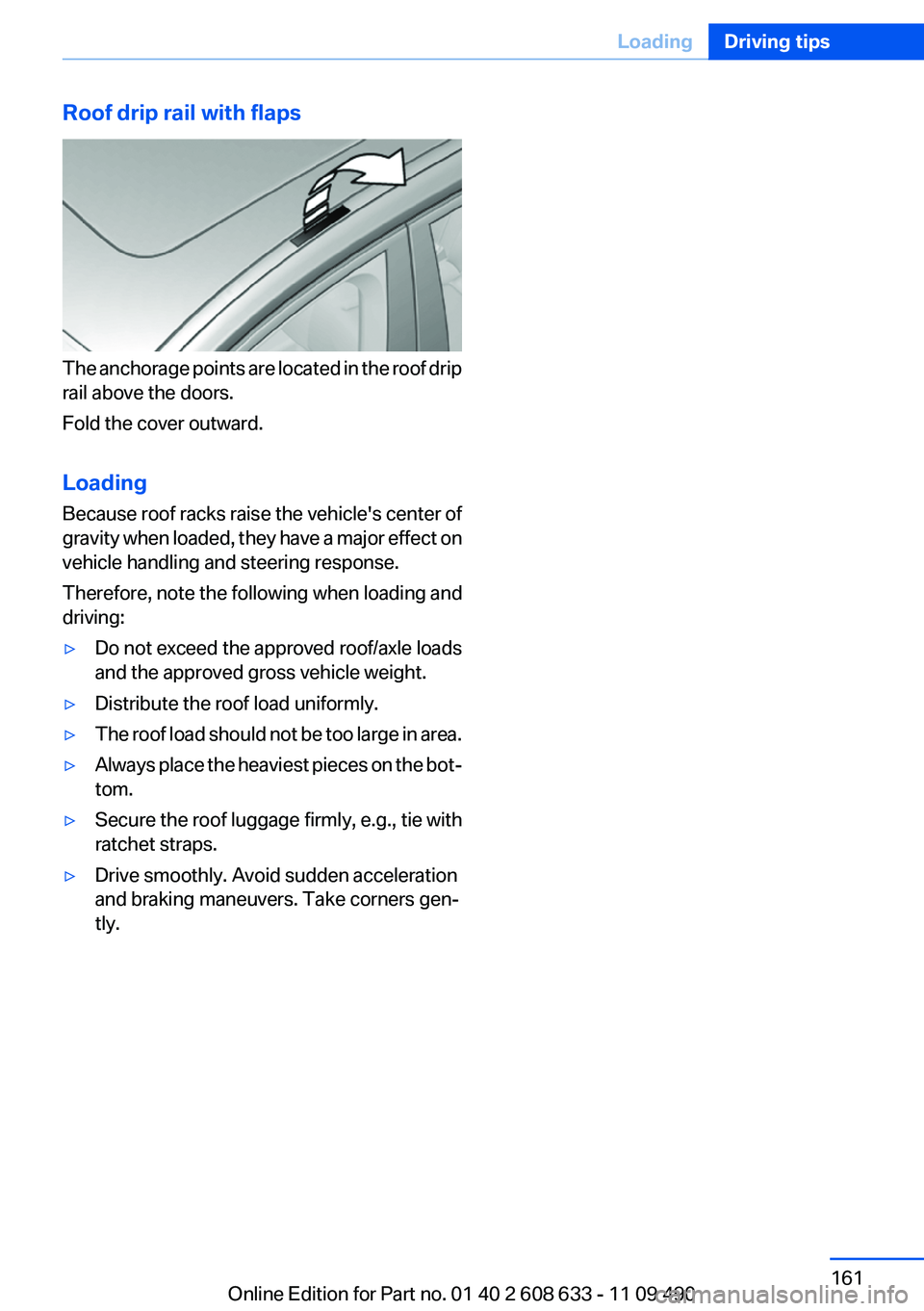
Roof drip rail with flaps
The anchorage points are located in the roof drip
rail above the doors.
Fold the cover outward.
Loading
Because roof racks raise the vehicle's center of
gravity when loaded, they have a major effect on
vehicle handling and steering response.
Therefore, note the following when loading and
driving:
▷Do not exceed the approved roof/axle loads
and the approved gross vehicle weight.
▷Distribute the roof load uniformly.
▷The roof load should not be too large in area.
▷Always place the heaviest pieces on the bot‐
tom.
▷Secure the roof luggage firmly, e.g., tie with
ratchet straps.
▷Drive smoothly. Avoid sudden acceleration
and braking maneuvers. Take corners gen‐
tly.
Seite 161
LoadingDriving tips
161Online Edition for Part no. 01 40 2 608 633 - 11 09 490
Page 162 of 325
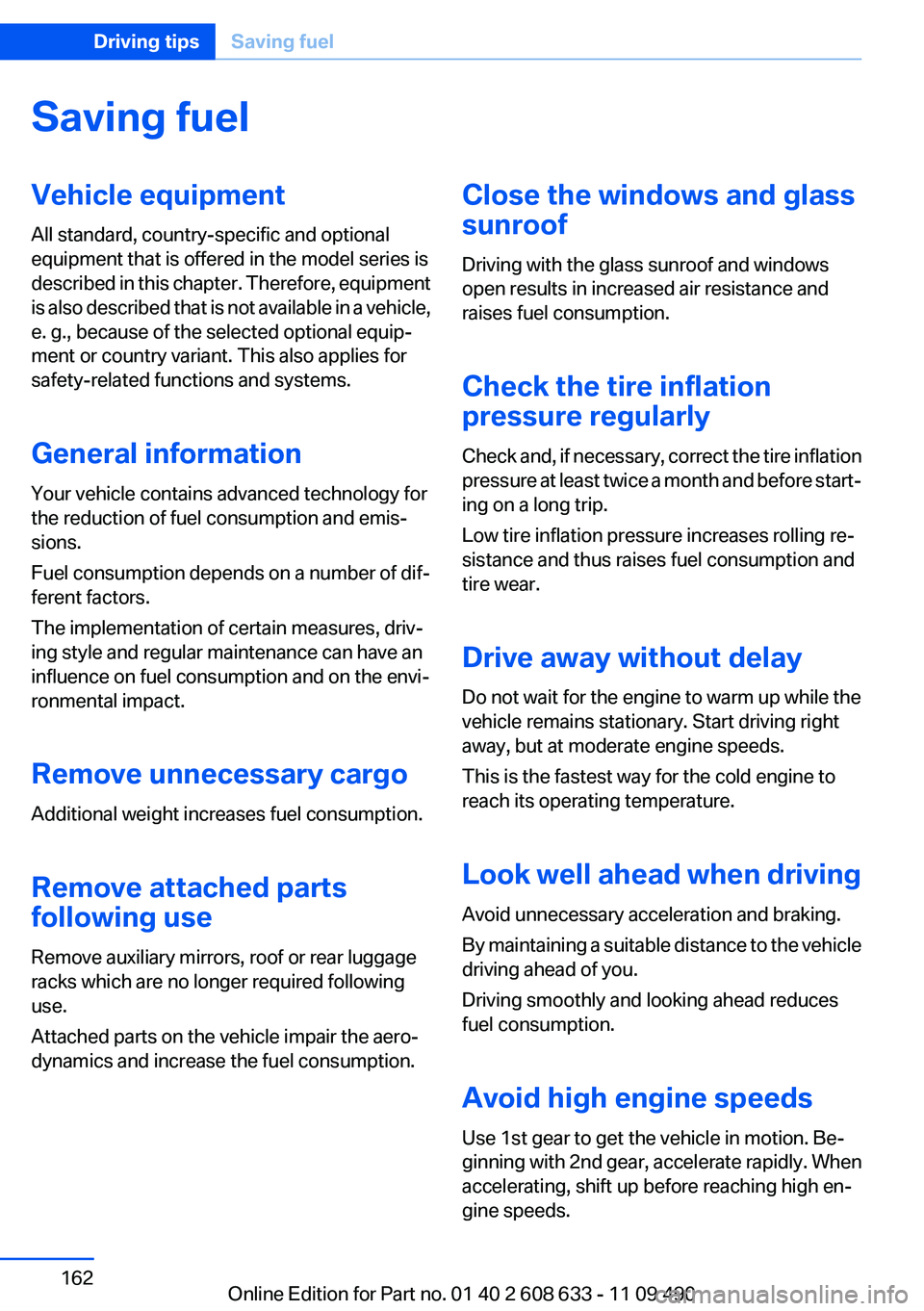
Saving fuel
Vehicle equipment
All standard, country-specific and optional
equipment that is offered in the model series is
described in this chapter. Therefore, equipment
is also described that is not available in a vehicle,
e. g., because of the selected optional equip‐
ment or country variant. This also applies for
safety-related functions and systems.
General information
Your vehicle contains advanced technology for
the reduction of fuel consumption and emis‐
sions.
Fuel consumption depends on a number of dif‐
ferent factors.
The implementation of certain measures, driv‐
ing style and regular maintenance can have an
influence on fuel consumption and on the envi‐
ronmental impact.
Remove unnecessary cargo
Additional weight increases fuel consumption.
Remove attached parts
following use
Remove auxiliary mirrors, roof or rear luggage
racks which are no longer required following
use.
Attached parts on the vehicle impair the aero‐
dynamics and increase the fuel consumption.
Close the windows and glass
sunroof
Driving with the glass sunroof and windows
open results in increased air resistance and
raises fuel consumption.
Check the tire inflation
pressure regularly
Check and, if necessary, correct the tire inflation
pressure at least twice a month and before start‐
ing on a long trip.
Low tire inflation pressure increases rolling re‐
sistance and thus raises fuel consumption and
tire wear.
Drive away without delay
Do not wait for the engine to warm up while the
vehicle remains stationary. Start driving right
away, but at moderate engine speeds.
This is the fastest way for the cold engine to
reach its operating temperature.
Look well ahead when driving
Avoid unnecessary acceleration and braking.
By maintaining a suitable distance to the vehicle
driving ahead of you.
Driving smoothly and looking ahead reduces
fuel consumption.
Avoid high engine speeds
Use 1st gear to get the vehicle in motion. Be‐
ginning with 2nd gear, accelerate rapidly. When
accelerating, shift up before reaching high en‐
gine speeds.
Seite 162
Driving tipsSaving fuel
162Online Edition for Part no. 01 40 2 608 633 - 11 09 490
Page 262 of 325
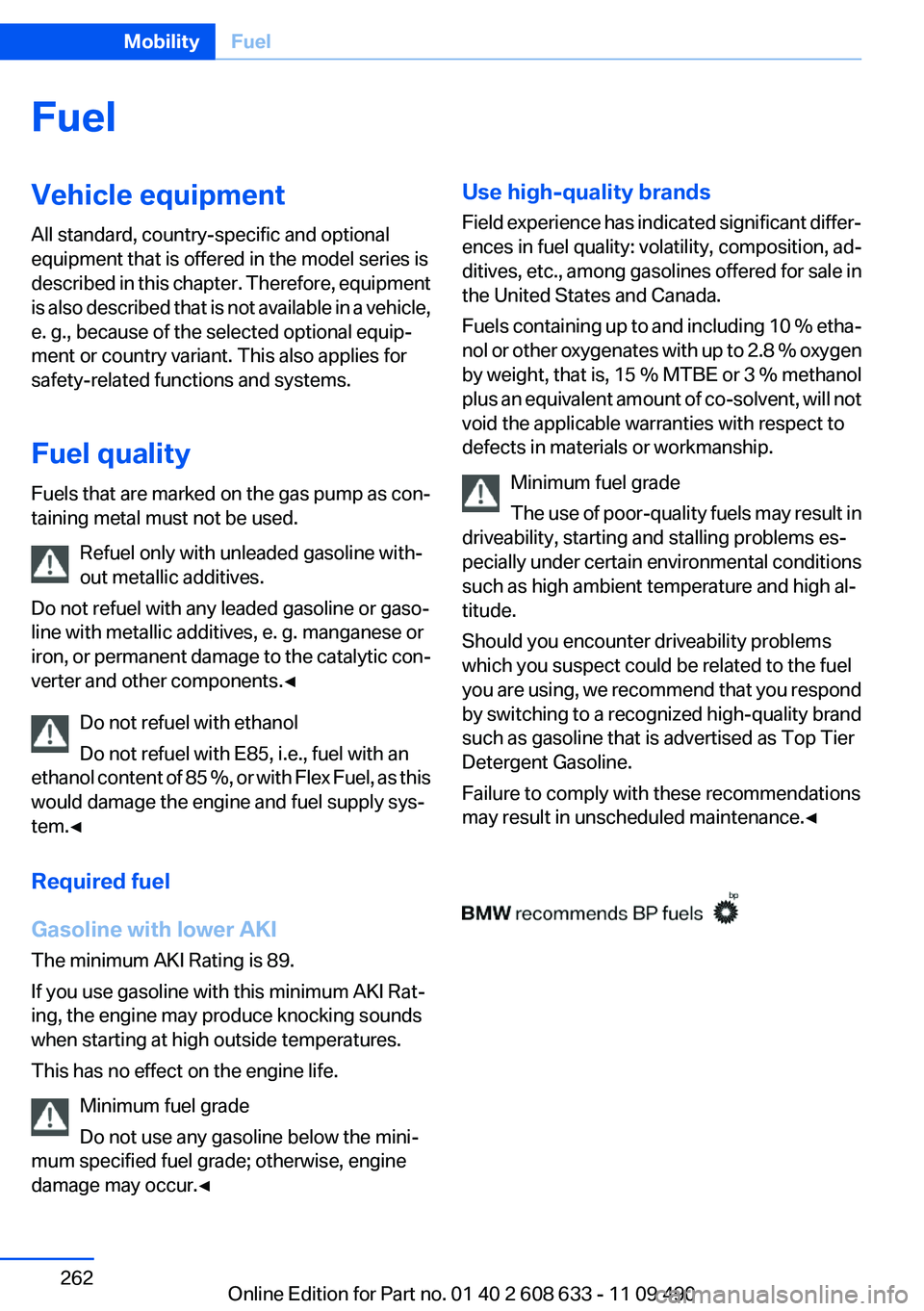
Fuel
Vehicle equipment
All standard, country-specific and optional
equipment that is offered in the model series is
described in this chapter. Therefore, equipment
is also described that is not available in a vehicle,
e. g., because of the selected optional equip‐
ment or country variant. This also applies for
safety-related functions and systems.
Fuel quality
Fuels that are marked on the gas pump as con‐
taining metal must not be used.
Refuel only with unleaded gasoline with‐
out metallic additives.
Do not refuel with any leaded gasoline or gaso‐
line with metallic additives, e. g. manganese or
iron, or permanent damage to the catalytic con‐
verter and other components.◀
Do not refuel with ethanol
Do not refuel with E85, i.e., fuel with an
ethanol content of 85 %, or with Flex Fuel, as this
would damage the engine and fuel supply sys‐
tem.◀
Required fuel
Gasoline with lower AKI
The minimum AKI Rating is 89.
If you use gasoline with this minimum AKI Rat‐
ing, the engine may produce knocking sounds
when starting at high outside temperatures.
This has no effect on the engine life.
Minimum fuel grade
Do not use any gasoline below the mini‐
mum specified fuel grade; otherwise, engine
damage may occur.◀
Use high-quality brands
Field experience has indicated significant differ‐
ences in fuel quality: volatility, composition, ad‐
ditives, etc., among gasolines offered for sale in
the United States and Canada.
Fuels containing up to and including 10 % etha‐
nol or other oxygenates with up to 2.8 % oxygen
by weight, that is, 15 % MTBE or 3 % methanol
plus an equivalent amount of co-solvent, will not
void the applicable warranties with respect to
defects in materials or workmanship.
Minimum fuel grade
The use of poor-quality fuels may result in
driveability, starting and stalling problems es‐
pecially under certain environmental conditions
such as high ambient temperature and high al‐
titude.
Should you encounter driveability problems
which you suspect could be related to the fuel
you are using, we recommend that you respond
by switching to a recognized high-quality brand
such as gasoline that is advertised as Top Tier
Detergent Gasoline.
Failure to comply with these recommendations
may result in unscheduled maintenance.◀
Seite 262
MobilityFuel
262Online Edition for Part no. 01 40 2 608 633 - 11 09 490
Page 304 of 325
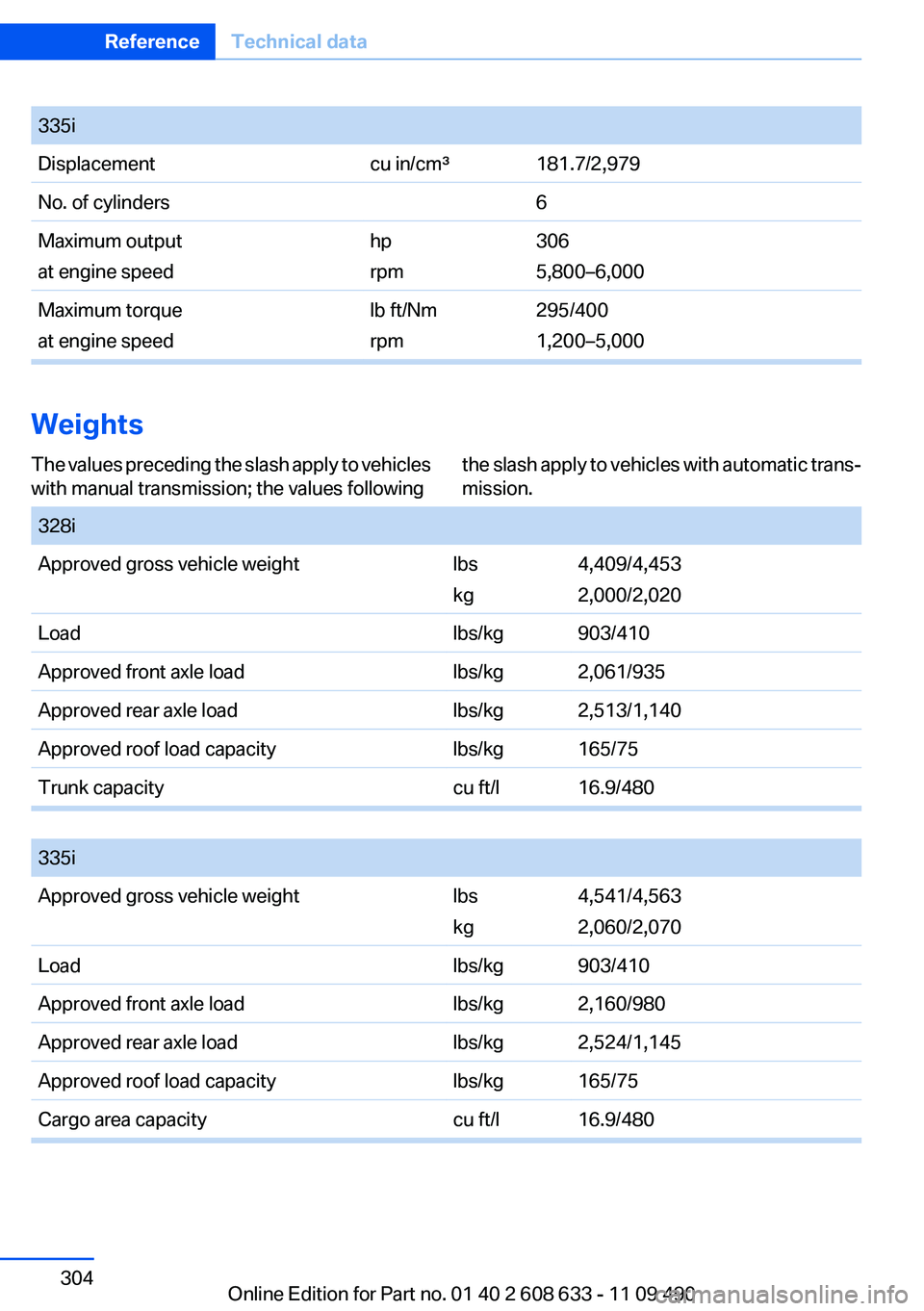
335i
Displacementcu in/cm³ 181.7/2,979
No. of cylinders6
Maximum output
at engine speed
hp
rpm
306
5,800–6,000
Maximum torque
at engine speed
lb ft/Nm
rpm
295/400
1,200–5,000
Weights
The values preceding the slash apply to vehicles
with manual transmission; the values following
the slash apply to vehicles with automatic trans‐
mission.
328i
Approved gross vehicle weightlbs
kg
4,409/4,453
2,000/2,020
Loadlbs/kg 903/410
Approved front axle loadlbs/kg 2,061/935
Approved rear axle loadlbs/kg 2,513/1,140
Approved roof load capacitylbs/kg 165/75
Trunk capacitycu ft/l 16.9/480
335i
Approved gross vehicle weightlbs
kg
4,541/4,563
2,060/2,070
Loadlbs/kg 903/410
Approved front axle loadlbs/kg 2,160/980
Approved rear axle loadlbs/kg 2,524/1,145
Approved roof load capacitylbs/kg 165/75
Cargo area capacitycu ft/l 16.9/480
Seite 304
ReferenceTechnical data
304Online Edition for Part no. 01 40 2 608 633 - 11 09 490
Page 314 of 325
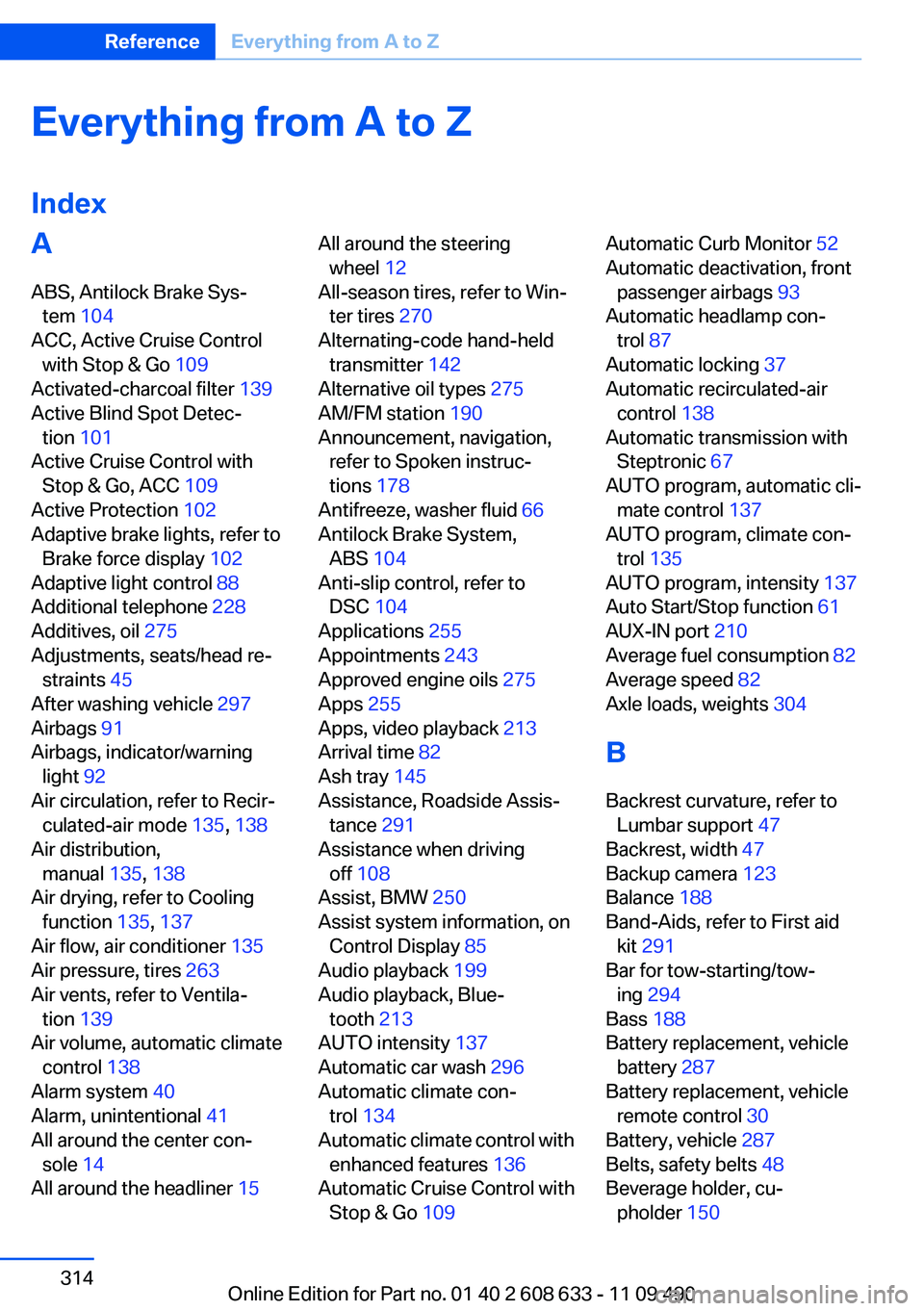
Everything from A to Z
Index
A
ABS, Antilock Brake Sys‐
tem 104
ACC, Active Cruise Control
with Stop & Go 109
Activated-charcoal filter 139
Active Blind Spot Detec‐
tion 101
Active Cruise Control with
Stop & Go, ACC 109
Active Protection 102
Adaptive brake lights, refer to
Brake force display 102
Adaptive light control 88
Additional telephone 228
Additives, oil 275
Adjustments, seats/head re‐
straints 45
After washing vehicle 297
Airbags 91
Airbags, indicator/warning
light 92
Air circulation, refer to Recir‐
culated-air mode 135, 138
Air distribution,
manual 135, 138
Air drying, refer to Cooling
function 135, 137
Air flow, air conditioner 135
Air pressure, tires 263
Air vents, refer to Ventila‐
tion 139
Air volume, automatic climate
control 138
Alarm system 40
Alarm, unintentional 41
All around the center con‐
sole 14
All around the headliner 15
All around the steering
wheel 12
All-season tires, refer to Win‐
ter tires 270
Alternating-code hand-held
transmitter 142
Alternative oil types 275
AM/FM station 190
Announcement, navigation,
refer to Spoken instruc‐
tions 178
Antifreeze, washer fluid 66
Antilock Brake System,
ABS 104
Anti-slip control, refer to
DSC 104
Applications 255
Appointments 243
Approved engine oils 275
Apps 255
Apps, video playback 213
Arrival time 82
Ash tray 145
Assistance, Roadside Assis‐
tance 291
Assistance when driving
off 108
Assist, BMW 250
Assist system information, on
Control Display 85
Audio playback 199
Audio playback, Blue‐
tooth 213
AUTO intensity 137
Automatic car wash 296
Automatic climate con‐
trol 134
Automatic climate control with
enhanced features 136
Automatic Cruise Control with
Stop & Go 109
Automatic Curb Monitor 52
Automatic deactivation, front
passenger airbags 93
Automatic headlamp con‐
trol 87
Automatic locking 37
Automatic recirculated-air
control 138
Automatic transmission with
Steptronic 67
AUTO program, automatic cli‐
mate control 137
AUTO program, climate con‐
trol 135
AUTO program, intensity 137
Auto Start/Stop function 61
AUX-IN port 210
Average fuel consumption 82
Average speed 82
Axle loads, weights 304
B
Backrest curvature, refer to
Lumbar support 47
Backrest, width 47
Backup camera 123
Balance 188
Band-Aids, refer to First aid
kit 291
Bar for tow-starting/tow‐
ing 294
Bass 188
Battery replacement, vehicle
battery 287
Battery replacement, vehicle
remote control 30
Battery, vehicle 287
Belts, safety belts 48
Beverage holder, cu‐
pholder 150
Seite 314
ReferenceEverything from A to Z
314Online Edition for Part no. 01 40 2 608 633 - 11 09 490
Page 317 of 325
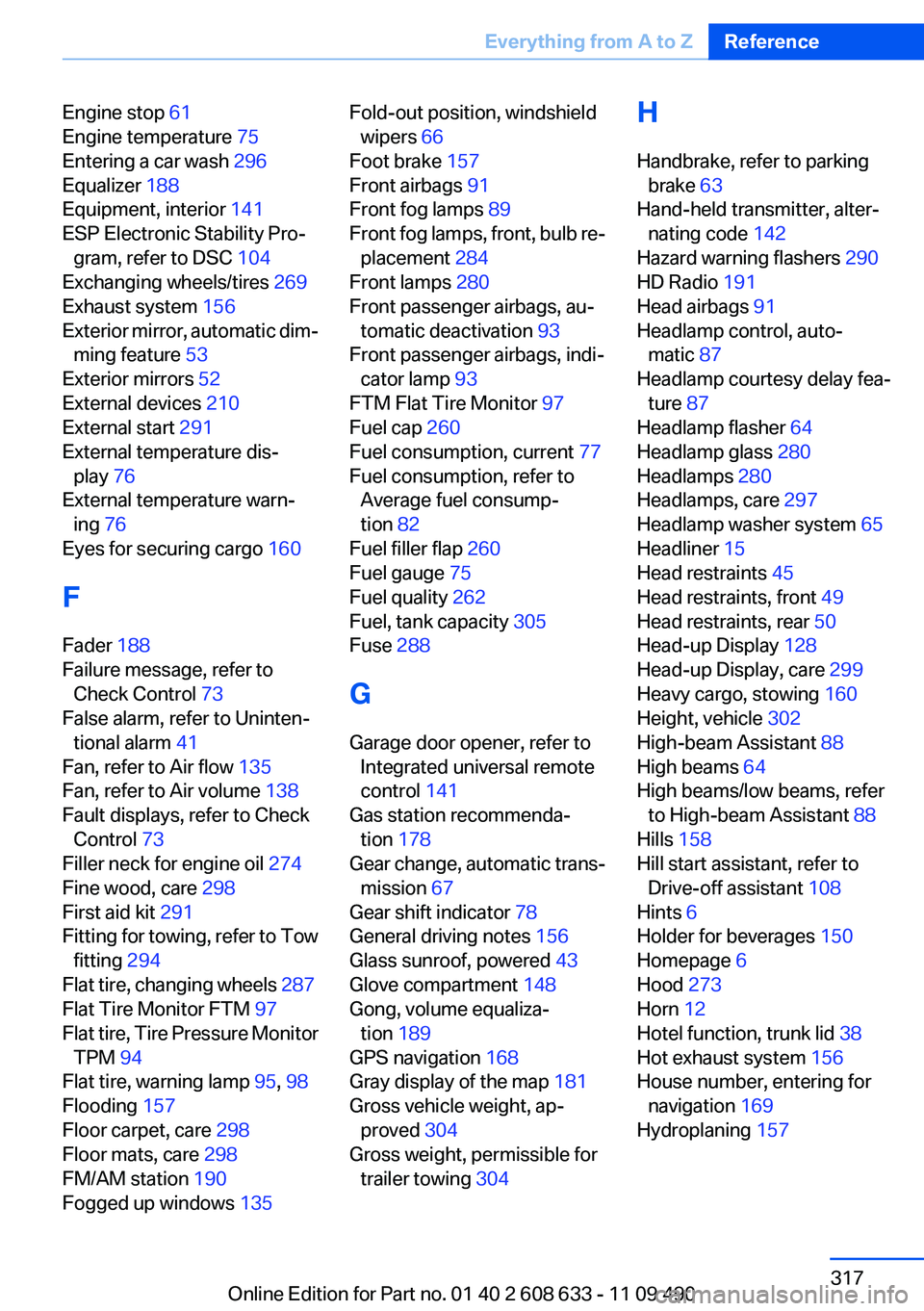
Engine stop 61
Engine temperature 75
Entering a car wash 296
Equalizer 188
Equipment, interior 141
ESP Electronic Stability Pro‐
gram, refer to DSC 104
Exchanging wheels/tires 269
Exhaust system 156
Exterior mirror, automatic dim‐
ming feature 53
Exterior mirrors 52
External devices 210
External start 291
External temperature dis‐
play 76
External temperature warn‐
ing 76
Eyes for securing cargo 160
F
Fader 188
Failure message, refer to
Check Control 73
False alarm, refer to Uninten‐
tional alarm 41
Fan, refer to Air flow 135
Fan, refer to Air volume 138
Fault displays, refer to Check
Control 73
Filler neck for engine oil 274
Fine wood, care 298
First aid kit 291
Fitting for towing, refer to Tow
fitting 294
Flat tire, changing wheels 287
Flat Tire Monitor FTM 97
Flat tire, Tire Pressure Monitor
TPM 94
Flat tire, warning lamp 95, 98
Flooding 157
Floor carpet, care 298
Floor mats, care 298
FM/AM station 190
Fogged up windows 135
Fold-out position, windshield
wipers 66
Foot brake 157
Front airbags 91
Front fog lamps 89
Front fog lamps, front, bulb re‐
placement 284
Front lamps 280
Front passenger airbags, au‐
tomatic deactivation 93
Front passenger airbags, indi‐
cator lamp 93
FTM Flat Tire Monitor 97
Fuel cap 260
Fuel consumption, current 77
Fuel consumption, refer to
Average fuel consump‐
tion 82
Fuel filler flap 260
Fuel gauge 75
Fuel quality 262
Fuel, tank capacity 305
Fuse 288
G
Garage door opener, refer to
Integrated universal remote
control 141
Gas station recommenda‐
tion 178
Gear change, automatic trans‐
mission 67
Gear shift indicator 78
General driving notes 156
Glass sunroof, powered 43
Glove compartment 148
Gong, volume equaliza‐
tion 189
GPS navigation 168
Gray display of the map 181
Gross vehicle weight, ap‐
proved 304
Gross weight, permissible for
trailer towing 304
H
Handbrake, refer to parking
brake 63
Hand-held transmitter, alter‐
nating code 142
Hazard warning flashers 290
HD Radio 191
Head airbags 91
Headlamp control, auto‐
matic 87
Headlamp courtesy delay fea‐
ture 87
Headlamp flasher 64
Headlamp glass 280
Headlamps 280
Headlamps, care 297
Headlamp washer system 65
Headliner 15
Head restraints 45
Head restraints, front 49
Head restraints, rear 50
Head-up Display 128
Head-up Display, care 299
Heavy cargo, stowing 160
Height, vehicle 302
High-beam Assistant 88
High beams 64
High beams/low beams, refer
to High-beam Assistant 88
Hills 158
Hill start assistant, refer to
Drive-off assistant 108
Hints 6
Holder for beverages 150
Homepage 6
Hood 273
Horn 12
Hotel function, trunk lid 38
Hot exhaust system 156
House number, entering for
navigation 169
Hydroplaning 157
Seite 317
Everything from A to ZReference
317Online Edition for Part no. 01 40 2 608 633 - 11 09 490
Page 322 of 325
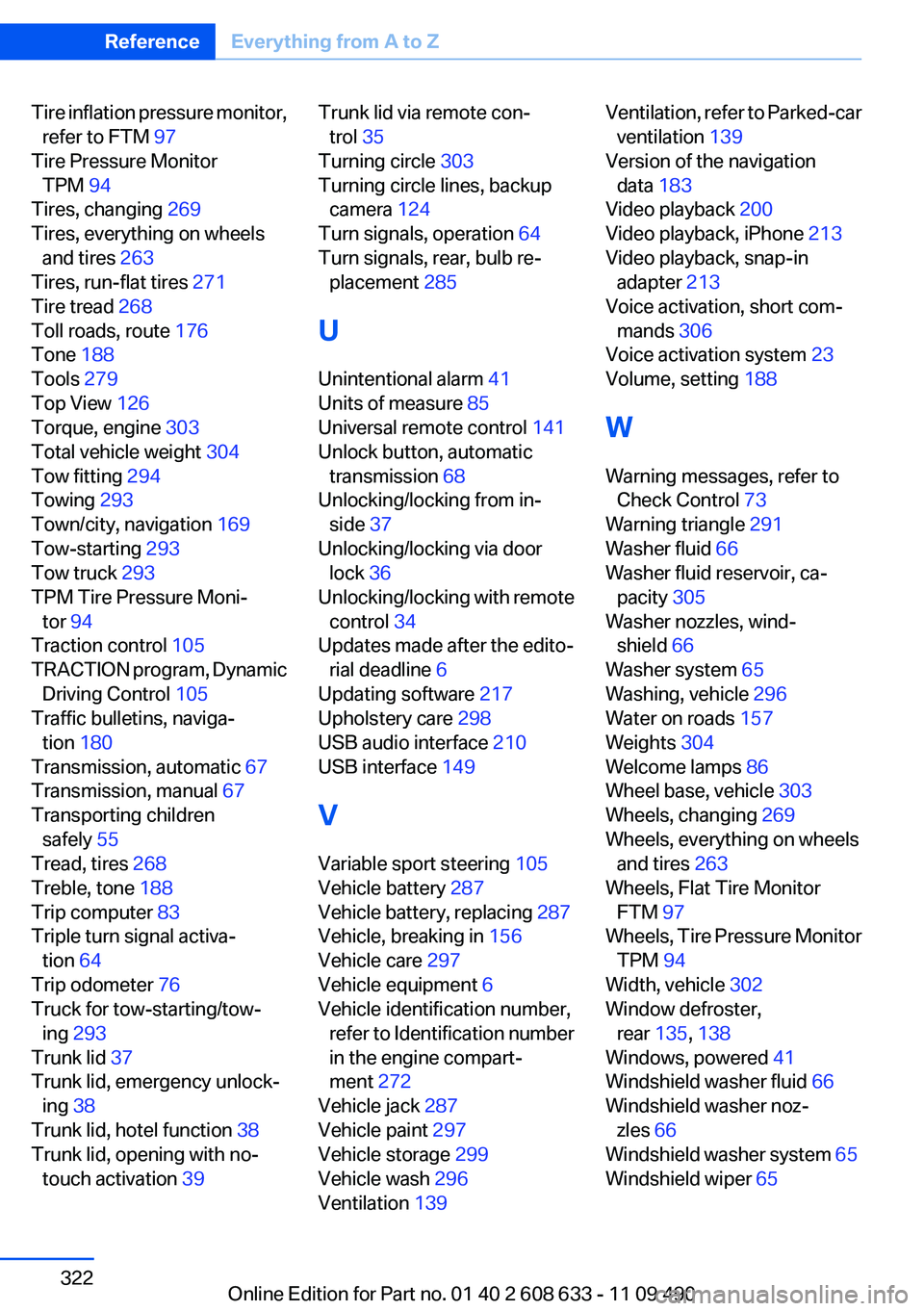
Tire inflation pressure monitor,
refer to FTM 97
Tire Pressure Monitor
TPM 94
Tires, changing 269
Tires, everything on wheels
and tires 263
Tires, run-flat tires 271
Tire tread 268
Toll roads, route 176
Tone 188
Tools 279
Top View 126
Torque, engine 303
Total vehicle weight 304
Tow fitting 294
Towing 293
Town/city, navigation 169
Tow-starting 293
Tow truck 293
TPM Tire Pressure Moni‐
tor 94
Traction control 105
TRACTION program, Dynamic
Driving Control 105
Traffic bulletins, naviga‐
tion 180
Transmission, automatic 67
Transmission, manual 67
Transporting children
safely 55
Tread, tires 268
Treble, tone 188
Trip computer 83
Triple turn signal activa‐
tion 64
Trip odometer 76
Truck for tow-starting/tow‐
ing 293
Trunk lid 37
Trunk lid, emergency unlock‐
ing 38
Trunk lid, hotel function 38
Trunk lid, opening with no-
touch activation 39
Trunk lid via remote con‐
trol 35
Turning circle 303
Turning circle lines, backup
camera 124
Turn signals, operation 64
Turn signals, rear, bulb re‐
placement 285
U
Unintentional alarm 41
Units of measure 85
Universal remote control 141
Unlock button, automatic
transmission 68
Unlocking/locking from in‐
side 37
Unlocking/locking via door
lock 36
Unlocking/locking with remote
control 34
Updates made after the edito‐
rial deadline 6
Updating software 217
Upholstery care 298
USB audio interface 210
USB interface 149
V
Variable sport steering 105
Vehicle battery 287
Vehicle battery, replacing 287
Vehicle, breaking in 156
Vehicle care 297
Vehicle equipment 6
Vehicle identification number,
refer to Identification number
in the engine compart‐
ment 272
Vehicle jack 287
Vehicle paint 297
Vehicle storage 299
Vehicle wash 296
Ventilation 139
Ventilation, refer to Parked-car
ventilation 139
Version of the navigation
data 183
Video playback 200
Video playback, iPhone 213
Video playback, snap-in
adapter 213
Voice activation, short com‐
mands 306
Voice activation system 23
Volume, setting 188
W
Warning messages, refer to
Check Control 73
Warning triangle 291
Washer fluid 66
Washer fluid reservoir, ca‐
pacity 305
Washer nozzles, wind‐
shield 66
Washer system 65
Washing, vehicle 296
Water on roads 157
Weights 304
Welcome lamps 86
Wheel base, vehicle 303
Wheels, changing 269
Wheels, everything on wheels
and tires 263
Wheels, Flat Tire Monitor
FTM 97
Wheels, Tire Pressure Monitor
TPM 94
Width, vehicle 302
Window defroster,
rear 135, 138
Windows, powered 41
Windshield washer fluid 66
Windshield washer noz‐
zles 66
Windshield washer system 65
Windshield wiper 65
Seite 322
ReferenceEverything from A to Z
322Online Edition for Part no. 01 40 2 608 633 - 11 09 490